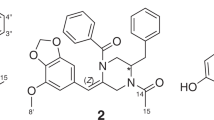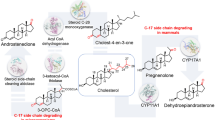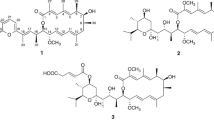Abstract
Many naturally occurring sterols are accumulated and metabolized byTetrahymena pyriformis. In most cases, the sterols are desaturated to giveΔ5,7,22-derivatives. Compounds with an ethyl, but not with a methyl, substituent at C-24 are dealkylated. Exposure of the ciliates to the appropriate sterol sharply curtails the synthesis of the native pentacyclic triterpenoid alcohols, tetrahymanol and diplopterol. An analysis with modified sterols has revealed several additional features that are required for desaturation at C-7,8 and C-22,23 and for inhibition of tetrahymanol biosynthesis. The presence of atrans-17(20)-double bond, which eliminates free rotation at C-20 and fixes C-22 to the right of the nucleus, does not interfere with desaturation, while thecis- or left-handed isomer is not metabolized. Thecis-Δ17(20)-isomer is, however, an effective inhibitor of tetrahymanol biosynthesis, although less so that thetrans-counterpart. When a methyl or hydroxyl group at C-20 protrudes to the front of the molecule in the right-handed conformation, metabolism is reduced or abolished. Shortening (by one C-atom) or lengthening of the sterol side chain has little effect on the ability of the compounds to inhibit tetrahymanol biosynthesis or to support growth, as long as the overall length of the side chain does not exceed seven carbons from C-20. The presence of a 7α-, 7β-, 20α-, 20β-, or a 25-hydroxy group in the cholesterol molecule sharply inhibits desaturation and curtails the effectiveness of the compound as an inhibitor of tetrahymanol biosynthesis. The 7- or 22-keto derivatives seem to act in a fashion similar to the hydroxy derivatives, but these compounds show greater inhibition of growth. 20-Methylcholesterol, however, is a potent inhibitor of synthesis, which suggests that the polarity of the substituent of C-20 is more important than bulk. Many sterols can effectively replace tetrahymanol in the membranes of these ciliates. However, several of the compounds, which inhibit synthesis, appear to be physiologically inappropriate, and poor growth results. An example of the latter class is 20-methylcholesterol. Finally, a class of sterols, represented by 20α-hydroxycholesterol and 7-ketocholesterol, does not severly inhibit tetrahymanol synthesis but leads to growth inhibition and surface abnormalities. These sterols apparently lead to a disordered membrane, even in the presence of tetrahymanol.
Similar content being viewed by others
References
Kidder, G.W., and V.C. Dewey, in “The Biochemistry and Physiology of Protozoa,” Vol. 1, Edited by A. Lwoff, Academic Press, New York 1951, p. 232.
Van Wagtendonk, W.J., R.L. Conner, C.A. Miller, and M.R.R. Rao, Ann. N.Y. Acad. Sci. 56:929 (1953).
Conner, R.L., and W.J. Van Wagtendonk, J. Gen. Microbiol. 12:31 (1955).
Conner, R.L., J.R. Landrey, E.S. Kaneshiro, and W.J. Van Wagtendonk, Biochim. Biophys. Acta 239:312 (1971).
Conner, R.L., and F. Ungar, Exp. Cell Res. 36:134 (1964).
Conner, R.L., J.R. Landrey, C.H. Burns, and F.B. Mallory, J. Protozool. 15:600 (1968).
Caspi, E., J.B. Greig, and J.M. Zander, Biochem. J. 109:931 (1968).
Caspi, E., J.B., Greig, and J.M. Zander, Chem. Commun. 28(1969).
Zander, J.M., J.B. Greig, and E. Caspi, J. Biol. Chem. 245:1247 (1970).
Mallory, F.B., R.L. Conner, J.R. Landrey, J.M. Zander, J.B. Greig, and E. Caspi, J. Am. Chem. Soc. 90:3564 (1968).
Caspi, E., J.M. Zander, J.B. Greig, F.B. Mallory, R.L. Conner, and J.R. Landrey, J. Am. Chem. Soc. 90:3563 (1968).
Conner, R.L., F.B. Mallory, J.R. Landrey, K.A. Ferguson, E.S. Kaneshiro, and E. Ray, Biochem. Biophys. Res. Commun. 44:995 (1971).
Nozawa, Y., and G.A. Thompson, Jr., J. Cell Biol. 49:712 (1971).
Ferguson, K.A., F.M. Davis, R.L. Conner, J.R. Landrey, and F.B. Mallory, J. Biol. Chem. 250:6998 (1975).
Conner, R.L., F.B. Mallory, J.R. Landrey, and C.W.L. Iyengar, J. Biol. Chem. 244:2325 (1969).
Mallory, F.B., and R.L. Conner, Lipids 6:149 (1971).
Nes, W.R., P.A. Malya, F.B. Mallory, K.A. Ferguson, J.R. Landrey, and R.L. Conner, J. Biol. Chem. 246:561 (1971).
Nes, W.R., J.M. Joseph, J.R. Landrey, and R.L. Conner, J. Biol. Chem. 253:2361 (1978).
Bipson, T., L.J. Goad, and T.W. Goodwin, Biochem. J. 115:857 (1967).
Wilton, D.C., and M. Akhtar, Biochem. J. 116:337 (1970).
Zander, J.M., and E. Caspi, J. Biol. Chem. 245:1682 (1970).
Mulheirn, L.J., D.J. Aberhart, and E. Caspi, J. Biol. Chem. 246:6556 (1971).
Nes, W.R., A. Alcaide, F.B. Mallory, J.R. Landrey, and R.L. Conner, Lipids 10:140 (1975).
Nes, W.R., K. Krevitz, S. Behzadan, G.W. Patterson, J.R. Landrey, and R.L. Conner, Biochem. Biophys. Res. Commun. 66:1462 (1975).
Britt, J.J., and K. Bloch, Comp. Biochem. Physiol. 2:213 (1961).
Calimbas, T., Fed. Proc. 31:430 (1972).
Calimbas, T., Fed. Proc. 32:519 (1973).
Dempsey, M.E., Ann. Rev. Biochem. 43:967 (1974).
Kandutsch, A.A., and H.W. Chen, J. Biol. Chem. 248:8408 (1973).
Brown, M.S., and J.L. Goldstein J. Biol. Chem. 249:7306 (1974).
Kandutsch, A.A., and H.W. Chen, J. Biol. Chem. 249:6057 (1974).
Breslow, J.L., D.A. Lothrop, D.R. Spaulding, and A.A. Kandutsch, Biochim. Biophys. Acta 398:10 (1975).
Kandutsch, A.A., and H.W. Chen, J. Cell Physiol. 85:415 (1975).
Schroepfer, G.J., E.J. Parish, H.W. Chen, and A.A. Kandutsch, J. Biol. Chem. 252:8975 (1977).
Kandutsch, A.A., H.W. Chen, and E.P. Shown, Proc. Natl. Acad. Sci. USA 74:2500 (1977).
Author information
Authors and Affiliations
About this article
Cite this article
Conner, R.L., Landrey, J.R., Joseph, J.M. et al. The steric requirements for sterol inhibition of tetrahymanol biosynthesis. Lipids 13, 692–696 (1978). https://doi.org/10.1007/BF02533747
Received:
Issue Date:
DOI: https://doi.org/10.1007/BF02533747




